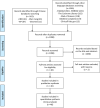Efficacy and safety of dietary polyphenol supplementation in the treatment of non-alcoholic fatty liver disease: A systematic review and meta-analysis
- PMID: 36159792
- PMCID: PMC9500378
- DOI: 10.3389/fimmu.2022.949746
Efficacy and safety of dietary polyphenol supplementation in the treatment of non-alcoholic fatty liver disease: A systematic review and meta-analysis
Abstract
Background: Dietary polyphenol treatment of non-alcoholic fatty liver disease (NAFLD) is a novel direction, and the existing clinical studies have little effective evidence for its therapeutic effect, and some studies have inconsistent results. The effectiveness of dietary polyphenols in the treatment of NAFLD is still controversial. The aim of this study was to evaluate the therapeutic efficacy of oral dietary polyphenols in patients with NAFLD.
Methods: The literature (both Chinese and English) published before 30 April 2022 in PubMed, Cochrane, Medline, CNKI, and other databases on the treatment of NAFLD with dietary polyphenols was searched. Manual screening, quality assessment, and data extraction of search results were conducted strictly according to the inclusion and exclusion criteria. RevMan 5.3 software was used to perform the meta-analysis.
Results: The RCTs included in this study involved dietary supplementation with eight polyphenols (curcumin, resveratrol, naringenin, anthocyanin, hesperidin, catechin, silymarin, and genistein) and 2,173 participants. This systematic review and meta-analysis found that 1) curcumin may decrease body mass index (BMI), Aspartate aminotransferase (AST), Alanine aminotransferase (ALT), Triglycerides (TG) total cholesterol (TC), and Homeostasis Model Assessment-Insulin Resistance (HOMA-IR) compared to placebo; and curcumin does not increase the occurrence of adverse events. 2) Although the meta-analysis results of all randomized controlled trials (RCTs) did not reveal significant positive changes, individual RCTs showed meaningful results. 3) Naringenin significantly decreased the percentage of NAFLD grade, TG, TC, and low-density lipoprotein cholesterol (LDL-C) and increased high-density lipoprotein cholesterol (HDL-C) but had no significant effect on AST and ALT, and it is a safe supplementation. 4) Only one team presents a protocol about anthocyanin (from Cornus mas L. fruit extract) in the treatment of NAFLD. 5) Hesperidin may decrease BMI, AST, ALT, TG, TC, HOMA-IR, and so on. 6) Catechin may decrease BMI, HOMA-IR, and TG level, and it was well tolerated by the patients. 7) Silymarin was effective in improving ALT and AST and reducing hepatic fat accumulation and liver stiffness in NAFLD patients.
Conclusion: Based on current evidence, curcumin can reduce BMI, TG, TC, liver enzymes, and insulin resistance; catechin can reduce BMI, insulin resistance, and TG effectively; silymarin can reduce liver enzymes. For resveratrol, naringenin, anthocyanin, hesperidin, and catechin, more RCTs are needed to further evaluate their efficacy and safety.
Keywords: dietary polyphenol; meta-analysis; natural plant active ingredients; non-alcoholic fatty liver disease; systematic review.
Copyright © 2022 Yang, Chen, Zhang, Yuan, Ge, Wang, Xu, Zeng and Ge.
Conflict of interest statement
The authors declare that the research was conducted in the absence of any commercial or financial relationships that could be construed as a potential conflict of interest.
Figures







Similar articles
-
Effects of different natural products in patients with non-alcoholic fatty liver disease-A network meta-analysis of randomized controlled trials.Phytother Res. 2024 Jul;38(7):3801-3824. doi: 10.1002/ptr.8182. Epub 2024 Jun 17. Phytother Res. 2024. PMID: 38886838 Review.
-
Efficacy of synbiotic supplementation in patients with nonalcoholic fatty liver disease: A systematic review and meta-analysis of clinical trials: Synbiotic supplementation and NAFLD.Crit Rev Food Sci Nutr. 2019;59(15):2494-2505. doi: 10.1080/10408398.2018.1458021. Epub 2018 Apr 20. Crit Rev Food Sci Nutr. 2019. PMID: 29584449
-
The effects of curcumin supplementation on liver function, metabolic profile and body composition in patients with non-alcoholic fatty liver disease: A systematic review and meta-analysis of randomized controlled trials.Complement Ther Med. 2020 Jan;48:102283. doi: 10.1016/j.ctim.2019.102283. Epub 2019 Dec 17. Complement Ther Med. 2020. PMID: 31987259
-
The clinical efficacy and safety of berberine in the treatment of non-alcoholic fatty liver disease: a meta-analysis and systematic review.J Transl Med. 2024 Mar 1;22(1):225. doi: 10.1186/s12967-024-05011-2. J Transl Med. 2024. PMID: 38429794 Free PMC article.
-
Effects of curcumin/turmeric supplementation on the liver enzymes, lipid profiles, glycemic index, and anthropometric indices in non-alcoholic fatty liver patients: An umbrella meta-analysis.Phytother Res. 2024 Feb;38(2):539-555. doi: 10.1002/ptr.8051. Epub 2023 Nov 2. Phytother Res. 2024. PMID: 37918958 Review.
Cited by
-
Maternal Polyphenols and Offspring Cardiovascular-Kidney-Metabolic Health.Nutrients. 2024 Sep 19;16(18):3168. doi: 10.3390/nu16183168. Nutrients. 2024. PMID: 39339768 Free PMC article. Review.
-
Investigating the effects of Ginkgo biloba leaf extract on cognitive function in Alzheimer's disease.CNS Neurosci Ther. 2024 Sep;30(9):e14914. doi: 10.1111/cns.14914. CNS Neurosci Ther. 2024. PMID: 39238068 Free PMC article.
-
Unlocking Cholesterol Metabolism in Metabolic-Associated Steatotic Liver Disease: Molecular Targets and Natural Product Interventions.Pharmaceuticals (Basel). 2024 Aug 15;17(8):1073. doi: 10.3390/ph17081073. Pharmaceuticals (Basel). 2024. PMID: 39204178 Free PMC article. Review.
-
Dietary Polyphenols and Gut Microbiota Cross-Talk: Molecular and Therapeutic Perspectives for Cardiometabolic Disease: A Narrative Review.Int J Mol Sci. 2024 Aug 22;25(16):9118. doi: 10.3390/ijms25169118. Int J Mol Sci. 2024. PMID: 39201807 Free PMC article. Review.
-
Green Tea Polyphenol (-)-Epicatechin Pretreatment Mitigates Hepatic Steatosis in an In Vitro MASLD Model.Curr Issues Mol Biol. 2024 Aug 16;46(8):8981-8994. doi: 10.3390/cimb46080531. Curr Issues Mol Biol. 2024. PMID: 39194748 Free PMC article.
References
Publication types
MeSH terms
Substances
LinkOut - more resources
Full Text Sources
Medical
Miscellaneous

